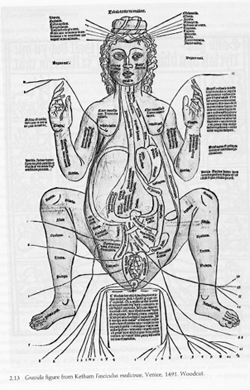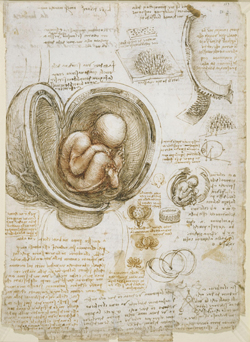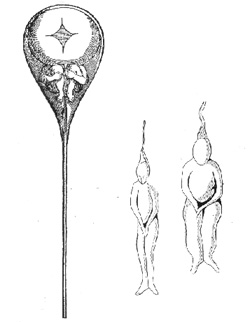6 Extremely Wrong (But Hilarious) Scientific Beliefs

Societal progress can feel incremental at the best of times, hopeless in bad times, and like a distant, beautiful daydream at the very worst. To fight this natural feeling of helplessness, we'd like to take a look back at some of the even dumber things our recent ancestors believed. It may not fix anything, but dammit, it feels good to laugh at the stupid stuff those dead assholes believed before we ourselves die and history turns us into the assholes. Anyway, here's some stuff about orgasms and poop.
A Person's Stupid Face Tells You Everything About Them
The 1500s-1700s were littered with pseudoscientific failures, but few were more overtly hilarious than physiognomy -- the idea that humans inherently possessed the personality traits of whatever animals they looked like. It's sort of like the Chinese zodiac, only more dickish.

In Ancient Greece, Aristotle wrote that large-headed people were mean, broad-faced ones were stupid, and round-faced ones were courageous. His head was presumably extremely round, giving him the courage to walk around telling two-thirds of Greece that they had weird heads which made them bad people. But the "modern" version of physiognomy is largely credited to the Italian scholar Giambattista della Porta, who published a widely circulated book in 1586 called De humana physiognomia (English translation: Snap-Judging The Shit Out Of People, But Like, In A 'Sciencey' Way). Della Porta was inspired by the "science" of alchemy, and believed that any substance could be distilled into its "pure essence," including humans. Thus was it possible to deduce someone's character from observation of their physical features. His hilariously on-the-nose side-by-side drawings proved this theory:

In the 18th century, natural philosophers went so far as to conclude that there was an "ideal" set of physical features, which were unsurprisingly the ones found in classical sculpture. "Others," like Asians and Africans, were deemed to be less beautiful and less moral. Scientific racism!
If You Had No Idea What An Animal Looked Like, You Guessed
If you want to look up the difference between turtles and tortoises, or simply want to see photos of a recovering alcoholic turtle celebrating the New Year responsibly, you can Google it in milliseconds. But way back before the internet, society basically had to take some rando explorer's word for it. It didn't matter if that eyewitness was a drunken sailor or an 80-year-old half-blind missionary -- the word of someone who had been overseas and glimpsed a thing was often enough to establish textbook canon for the following hundred years.
As an example, for centuries, whales were thought to be massive evil fish with fangs and scales and such. Not many science illustrators ever got to see a real whale, but that didn't stop them from winging it:

Then there were early 17th-century hippos, which were like tigers with dadbods.

Crocodiles were specifically drawn with human-like heads for a good while. Since artists didn't have the chance to see them in real life, someone came up with an idea of what it looked like. Namely, that it had a human face and a weird monkey tail. This then became the "model," and this was how the crocodile was drawn for centuries to come.

Occasionally, a painter would manage a relatively accurate version of an animal, like in Pieter Paul Rubens' 1616 painting "Hippopotamus And Crocodile Hunt," but by and large, we ended up drawing weird shit like this:

Clitoral Orgasms Were A Sign Of Insanity
In medieval times, some believed that the uterus was a "sewer" -- a poison-filled organ which existed to spread disease, like by "wandering" up into a woman's body and causing hysteria. It was likely a rich topic of conversation for hacky ancient stand-ups. But well into the late 1800s, Sigmund Freud argued that clitoral orgasms were signs of mental illness, and that clitorises were a direct cause of lesbianism, which was in turn a direct cause of burning in Hell, as well as of Freud needing to take another one of his trademark 15-minute "not-jerking-off breaks."

In 1873, a Harvard Medical School faculty member wrote that women's brains were less developed than men's, and that they couldn't handle the stimulation of higher education, especially during menstruation.

Even Leonardo da Vinci, whose 500-year-old drawings of anatomy remain incredibly accurate to this day, completely botched the female reproductive system. He did have a good excuse, though: The bodies he dissected for study were "unclaimed," usually of drunks or vagrants, who were far more likely to be male. So if only more Renaissance women had gotten plastered and died in the sewer with no loved ones around to bury them, we might've gotten decent female medicine a couple centuries earlier. Sorry ladies, that's on you.

Rain Is Caused By Digging Holes
In the late 1800s, weather forecasting was more than an inaccurate science; it was outright fatal. Americans popularly believed that "rain follows the plow" -- the idea that farming a particular plot of land made it more likely for it to rain in that area. Unusually high rainfall throughout the 1870s and 1880s helped "confirm" this theory, which resulted in millions of settlers digging up giant plots of land across the American West in the hopes of pleasing the rain gods. On top of the science being entirely false, this rampant over-plowing contributed to the Dust Bowl. A lot of the land was poorly tended, and became a source of the blowing soil that drifted across the land. Many of the westward settlers were inexperienced farmers who'd been won over by a huge advertising campaign designed specifically to encourage people to buy land and farm it.

The idea that "rain follows the plow" was considered valid until the 1890s, at which point severe droughts arrived and people put two and two together. Still, hardcore proponents of the theory insisted that the rain had stopped only because the settlers weren't plowing deep enough. Which, naturally, is the only logical explanation.
Poop Cures Everything
Most medieval doctors had no idea what was going on or what to do about it, so they would pull cures out of their asses -- literally. In medieval times, cures for diseases often called for the liberal application of shit. Anglo-Saxon medicine implemented the excrement of goats, sheep, horses, calves, oxen, and pigeons, mixed with different household ingredients. One headache cure, for example, called for a recipe of pigeon dung, incense, wheat flour, and egg white. Which are, incidentally, the exact same ingredients you'll find in a Cadbury Creme Egg.

The "Throw poo at it" approach remained a medical option in various forms long after the middle ages. 17th-century chemist Robert Boyle preached a treatment for cataracts which required human excrement to be dried into powder and then blown into the eye. An 18th-century minister promoted an epilepsy cure which urged the patient to swallow pulverized baby poop over the course of several days. Medieval medicine was an elaborate Jackass-style prank, with the reveal coming centuries after everyone had died from hardcore pinkeye.
Humans Start Out As Tiny Versions Of Themselves
In the 1600s-1700s, the scientific and religious communities (not entirely separate) widely believed in the concept of "preformation," which stated, essentially, that all species had been made by God at the time of Creation, and animals "growing" was simply the unfolding of preformed parts. So every creature, including humans, were biological Russian nesting dolls. Oddly enough, they were kind of right about people coming from tiny reproductive cells located in the parents, buuuut they fudged the specifics a wee bit, believing instead that a tiny intact human was chilling inside of a sperm cell .

The idea was that humans came to life when the minuscule adult got sick of chillaxing and decided to enlarge. Scientists could not agree if the teeny person was located in the sperm or the ovum. Looking back today, it doesn't matter which was accepted, because both work equally well for our purposes: laughing at old-timey idiots.
Think Nana and Pop-Pop's loving 60-year monogamous relationship is quaint and old-fashioned? First off, sorry for that disturbing image, but we've got some news for you: the monogamous sexual relationship is actually brand new relative to how long humans have been around. Secondly, it's about to get worse from here: monkey sex.
On this month's live podcast, Jack O'Brien and the Cracked staff welcome Dr. Christopher Ryan, podcaster and author of 'Sex at Dawn', onto the show for a lively Valentine's Day discussion about love, sex, why our genitals are where they are, and why we're more like chimps and bonobos than you think.
Get your tickets here:
For more crazy frightening things about our ancestors, check out The 10 Most Insane Medical Practices In History and 8 Terrifying Instruments Old-Time Doctors Used On Your Junk.
Subscribe to our YouTube channel, and check out 4 Awful Ways Our Ancestors Got High (That We Tested!), and other videos you won't see on the site!
Follow us on Facebook, and let's be best friends forever.








